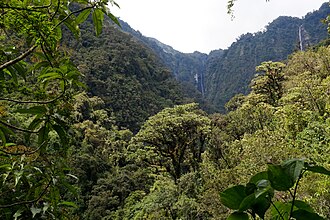Megadiversity

The term megadiversity denotes an extremely high level of species diversity or biodiversity , which is limited to a small number of areas worldwide.
Megadiversity countries
The nature conservation organization Conservation International developed the concept of megadiversity countries in 1988 . The first criterion for classification as a megadiversity country was endemism at the level of species , genera and families : at least 5,000 species of endemic plants must occur; that is, plant populations that have emerged exclusively in a certain area and only exist there, are spatially narrowly limited and thus potentially endangered. The second criterion is the existence of marine ecosystems. In addition to these two criteria, the number of endemic animals, general biodiversity and biodiversity at a higher level (i.e. also the diversity of ecosystems and in particular the existence of ecosystems of the tropical rainforest ) were also considered.
The 17 states declared megadiversity countries ( English megadiverse countries ) are home to over 70% of the species living on the land. Most of these countries are in the tropics . On February 17, 2002, representatives from twelve megadiversity countries met in Cancún . They signed the Cancún Declaration ( Like-Minded Megadiverse Countries , LMMC ). By 2003, two other countries followed suit.
| continent | country | known endemic species / group of animals |
|---|---|---|
| Africa | Democratic Republic of Congo | Bonobo |
| Africa | South Africa | Cape parrot |
| Africa | Madagascar | Lemurs |
| Asia | Indonesia | orangutan |
| Asia | India | Nilgau antelope |
| Asia | Malaysia | Malaysia tiger |
| Asia | People's Republic of China | Big panda |
| Asia | Philippines | Tamarau , Philippines tarsier |
| Oceania / Australia | Papua New Guinea | Giant tree rats |
| Oceania / Australia | Australia | Koala bear |
| North America | Mexico (including the Caribbean islands) | Tricolor angelfish |
| North America | United States | Forest rattlesnake |
| South America | Brazil | Northern spherical armadillo |
| South America | Colombia | Andean white-tailed hummingbird |
| South America | Ecuador including the Galápagos Islands | Darwin's finches |
| South America | Peru | Kotosh prairie mouse |
| South America | Venezuela | Merida Wren |
Megadiversity Centers
In relation to the number of species of vascular plants , Wilhelm Barthlott identifies five mega-diversity centers in which more than 5,000 species occur on 10,000 km² (for comparison, Germany has 500 to 2,000 species per 10,000 km², depending on the region):
- over 12,500 species (44% endemic ) - Costa Rica and Chocó (78,000 km² in Costa Rica and Colombia from 0 to 3,800 m above sea level)
- around 10,000 species (30% endemic) - Tropical Eastern Andes in Venezuela, Colombia, Ecuador and Peru (62,000 km² from 250 to 3,500 m above sea level)
- around 9,000 species (39% endemic) - North Borneo (57,000 km² in Malaysia and Indonesia from 0 to 4,100 m above sea level)
- over 6,000 species (75% endemic) - Mata Atlantica Brazil (50,000 km² from 0 to 2,800 m above sea level)
- over 6,000 species (33% endemic) - New Guinea (87,000 km² in Indonesia and Papua New Guinea from 0 to 4,500 m above sea level)
All the centers mentioned are located in the mountain forest of high tropical mountains and therefore extend from the fringes of the lowland rainforests up to the zone of cloud and cloud forests . Due to the large differences in height in hot, humid humid climates, there is inevitably a large number of very different habitats in a small area. This also applies, to a lesser extent, to mountainous countries in the subtropics and the cool, temperate climate zone , as can be seen from the world map of plant diversity .
See also
- Biodiversity Convention (1992)
- Cartagena Protocol (2000)
- Biodiversity hotspot
- Biodiversity of the Philippines
Web links
- Study Commission Globalization of the World Economy - Challenges and Answers (1999–2002): Final report, Chapter 7.3.1.4: Unequal distribution of biological diversity , Bundestag printed paper 17/9200 of June 12, 2002
Individual evidence
- ↑ Megadiverse Countries Biodiversity AZ, accessed December 30, 2018.
- ↑ Russell A. Mittermeier , Patricio Robles Gil, Cristina Goettsch Mittermeier (eds.): Megadiversity: Earth's Biologically Wealthiest Nations . Cemex, Mexico 1997. Also: Biodiversity Hotspots . Australian government
- ^ How can biotechnology benefit Latin America and the Caribbean? ( Memento of the original from December 12, 2011 in the Internet Archive ) Info: The archive link was automatically inserted and not yet checked. Please check the original and archive link according to the instructions and then remove this notice. (PDF; 28 kB) United Nations Industrial Development Organization, June 25, 2003
- ↑ Wilhelm Barthlott et al .: Geographical patterns of vascular plant diversity on a continental and global scale. Published in Erdkunde Vol. 61, no. 4 (October to December 2007) pp. 305-315, table p. 308, online version .

